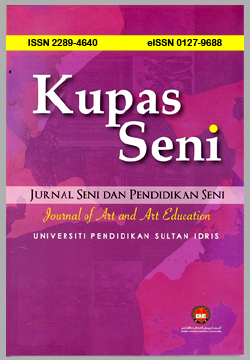The Used of Technology as an Approach to Art Appreciation Through Digital Museums
Penggunaan Teknologi sebagai Pendekatan kepada Apresiasi Seni melalui Muzium Digital
DOI:
https://doi.org/10.37134/kupasseni.vol11.2.1.2023Keywords:
teknologi, muzium digital, apreasi seniAbstract
Today's world is witnessing a very rapid development of technology all over the world. The boom in the use of this technology has changed the ecosystem in education and influenced the approach to art appreciation in Visual Arts Education subjects. This study aims to explore the diversity of technology and tools used for the purpose of art appreciation including the concept, characteristics and how the technology works. This qualitative study uses literature highlighting techniques as well as observation. The use of technology through digital museums is an effort to make it easier for teachers and students to meet the needs of art appreciation in education and also to preserve intangible cultural heritage so that it does not disappear. In conclusion, the digital museum is a technological revolution to maintain its function and role in art appreciation. The use of technology should be adapted taking into account ethical values to preserve and conserve works and artefacts to ensure continued accessibility and appreciation of art.
Downloads
References
Abdurrohman, Z., & Rosmansyah, Y. (2021). Rancang Bangun Sistem Visualisasi Masjid Salman Rasidi Menggunakan Virtual Reality. Jurnal Sistem Cerdas, 04(02), 67–75.
Anderson, S. L. R. (2019). The interactive museum: Video games as history lessons through lore and affective design. E-Learning and Digital Media, 16(3), 177–195. https://doi.org/10.1177/2042753019834957
Andre, L., Durksen, T., & Volman, M. L. (2017). Museums as avenues of learning for children: a decade of research. Learning Environments Research, 20(1), 47–76. https://doi.org/10.1007/s10984-016-9222-9
Anuar, A., & Aslina, M. J. (2021). Pemetaan Visual Realiti Maya 360 ° Secara Kreatif Digital. International Journal of Applied and Creative Arts, 4(1), 130–142.
Bovcon, N. (2021). Virtual museums: interpreting and recreating digital cultural content. Neohelicon, 48(1), 23–38. https://doi.org/10.1007/s11059-021-00582-1
Chen, R.-X., & Shih, N.-J. (2017). Regenerating the arts: Sculpture conservation and 3d panoramic guides at the Juming Museum, Taiwan. Journal of the Institute of Conservation, 40(3), 242–251. https://doi.org/10.1080/19455224.2017.1365741
Franceschi, R. B., & Álvarez, L. de M. (2021). Bibliographic review of the existence of virtual museums for educational purposes applied to the professional environment. Journal of Educational Technology and Online Learning, 4(3), 464–474. https://doi.org/10.31681/jetol.947155
Gaylord-opalewski, K., & O’Leary, L. (2019). Defining Interactive Virtual Learning in Museum Education : A Shared Perspective. Journal of Museum Education, 44(No.3), 229–241. https://doi.org/10.1080/10598650.2019.1621634
Han, M., & Yi, Y. (2022). Digital Exhibition of Intangible Heritage and the Role of Museums in COVID-19 Era — Focusing on Gwangju Chilseok Gossaum Nori Video Experience Center in South Korea. Heritage, 5(3), 2673–2688.
Harozila Ramli, Tajul Shuhaizam Said, Mohamad Nur Hanif Hazman, Syamrul Nizam Abdul Malek, & Ridzuan Hussin. (2019). The development and evaluation of an interactive multimedia module for the topic of art elements of the visual art education subject. International Journal of Innovation, Creativity and Change, 10(6), 246–258.
Hendra, P., Laente, H., Pamadhi, H., & Maulana, K. L. (2019). Museum as a Source of Learning Art Appreciation. 2nd International Conference on Art and Arts Education (ICAAE 2018), 327(Icaae 2018), 70–73. https://doi.org/10.2991/icaae-18.2019.14
Kannampuzha Varuthunny, L., & Venukapalli, S. (2021). Gender and Geocultural Diffrences in Children’s Appreciation of Art. American Journal of Art and Design, 6(2), 47. https://doi.org/10.11648/j.ajad.20210602.12
Kaplan, D. (2021). “ What Does It Matter Where My Body Happens to Be ?” A Personal View of Online Art Museum Tours. Journal of Museum Education, 46(4), 531–546. https://doi.org/10.1080/10598650.2021.1987768
Keong, L. K. (2019). The Impact of Virtual Simulation on Aesthetic Experience in Human Psychology and perception. ASWARA.
Kim, S., Im, D., Lee, J., & Choi, H. (2019). Utility of Digital Technologies for the Sustainability of Intangible Cultural Heritage ( ICH ) in Korea †. Sustainability, 11(21), 19.
Li, C. (2021). Art image simulation design of craft products based on virtual reality and human–computer interactive processing. Journal of Ambient Intelligence and Humanized Computing, 0123456789. https://doi.org/10.1007/s12652-021-03117-9
Lin, C., Chen, S., & Lin, R. (2020). Efficacy of Virtual Reality in Painting Art Exhibitions Appreciation. Applied Sciences, 1–15.
Liu, Pei. (2021). Application and Teaching Exploration of Virtual Reality Technology in Art Appreciation. International Journal of Learning and Teaching, 7(3). https://doi.org/10.18178/ijlt.7.3.187-193
Liu, Peng, & Lan, L. (2021). Museum as multisensorial site: story co-making and the affective interrelationship between museum visitors, heritage space, and digital storytelling. Museum Management and Curatorship, 36(4), 403–426. https://doi.org/10.1080/09647775.2021.1948905
Liu, Y., & Li, S. (2022). Construction of Ideological and Political Virtual Museum Based on VR Unity3D from the Perspective of Digital Humanities. In M. T.-H. (Ed.), International Conference on Computation, Big-Data and Engineering (ICCBE) (pp. 83–86). Institute of Electrical and Electronics Engineers Inc. https://doi.org/10.1109/ICCBE56101.2022.9888161
Omar, N. U., Wan, W. S. A., Daud, M., & Maaruf, S. Z. B. (2022). Art Appreciation Session in Visual Art Education. DESIGN-DECODED 2021:Proceedings of the 2nd International Conference on Design Industries & Creative Culture, 246. https://doi.org/10.4108/eai.24-8-2021.2315295
Razali, N. A. N. B. (2023). Kajian Tentang Pengalaman Pengguna Terhadap Penggunaan Muzium 360 Darjah di Muzium Negara, Malaysia. In Universiti Malaysia Kelantan. Universiti Malaysia Kelantan.
Sarah, W., Binti, Y., Azhar, W., & Sarim, H. M. (2021). Reka Bentuk Antara Muka Pameran 3D Pakaian Tradisional Melayu Berdasarkan Pengetahuan Pemeliharaan Terbenam.
Sri Yanti Mahadzir, N. Z. H. (2020). Pembangunan Lawatan Maya 360 Rumah Tradisional Melayu Sebagai Satu Usaha Pemeliharaan Senibina Warisan. Prosiding Persidangan Antarabangsa Pengajian Alam Melayu 2020, January 2023. https://www.researchgate.net/profile/Sri-Yanti-Mahadzir/publication/366847945_Pembangunan_Lawatan_Maya_360_Rumah_Tradisional_Melayu_Sebagai_Satu_Usaha_Pemeliharaan_Senibina_Warisan/links/63b512c3c3c99660ebc8c05e/Pembangunan-Lawatan-Maya-360-Rumah-Tradisio
Taranova, T. N. (2020). Virtual Museum Technologies and the Modern Educational Process. VI International Forum on Teacher Education, 1, 2513–2521. https://doi.org/10.3897/ap.2.e2513
Wulandari, Y. F., Caesariano, L., Murtiadi, & Bastian, Y. (2021). Virtual Tour Sebagai Media Komunikasi Digital Dalam Pelayanan Museum. 01, 9–15.
Downloads
Published
Issue
Section
License
Copyright (c) 2023 Salimah Jos, Nor Syazwani Mat Salleh

This work is licensed under a Creative Commons Attribution-NonCommercial-ShareAlike 4.0 International License.





